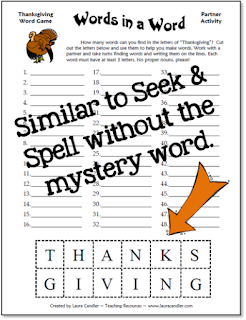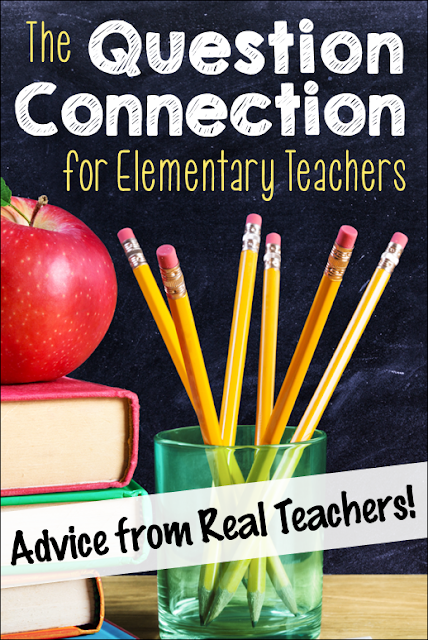Students are given a set of letter tiles that they use to create and record as many words as possible. Making words with letter tiles is not a unique concept, but Seek & Spell Challenge has a unique twist that makes it motivating and fun for kids. What's the secret sauce? Simply that all of the letters can be unscrambled to form a "mystery word," and kids love the challenge of searching for that word!
I first created Seek & Spell Challenge as a fun seatwork activity for my 5th graders to be used on special days, like the the morning of a field trip or the day before a holiday because it had a calming effect on the class and my students enjoyed it. But when I noticed how much my students' spelling and foundational reading skills were improving, I started including it as a regular work work activity in my literacy centers. The results were even more amazing when I used it weekly!
But about a month ago, I came across one of my old mystery word printables, and I realized that the original activity was worthy of being a separate product. Furthermore, it was so motivating and effective that it NEEDED to be shared with other teachers!
I decided to run the Seek & Spell Challenge concept by the elementary teachers in one of my Facebook groups to see what they thought about it. They loved the idea! So I invited those who were interested to work with me on the project. I had only used the activity with 5th graders, and I wanted to adapt it for younger students and test the activities in classrooms from 2nd grade to 5th grade.
As I created the mini-lessons and printables and shared them with the teachers, they offered great suggestions, like using lowercase letters instead of the uppercase letters I had been using. The 2nd grade teachers asked for a variation of the printable with fewer lines and larger spaces for recording words. Throughout the process, these amazing teachers tested the printables and activities in their classrooms. Everything worked perfectly as planned!
Click HERE to download a PDF preview.
What Teachers Love About Seek & Spell Challenge
I loved seeing the photos of students working with the materials, but the best part was reading feedback from the teachers about why they love the program. It was so validating to learn that what I had experienced in my classroom was happening in other classrooms, too. Here's what a few of teachers shared with me:Seek & Spell Challenge engaged my students and encouraged "real thinking" about words and their spelling. I loved watching teams of two work together and brainstorm and then check the word wall or their "quick words" for correct spelling. Having to find the "Mystery Word" was the bonus! The kids loved this concept and it provided a nice challenge for those who needed it. Manipulating the letters is important for student growth as it provides practice and exposure that they need as spellers, writers, and readers. ~ Cheryl Jordan, 2nd Grade
My students loved Seek & Spell Challenge! I had them work individually and then with a partner. They enjoyed comparing the words they each had made, finding those that were the same and those that were different. They saw that they could rearrange the letters in each other's "big" words and make smaller words too. I know there are similar word work activities; however, this packet is much more thoroughly put together and easier to prepare and use in the classroom. ~ Cheryl Barrios, 3rd and 4th Grade
I love how Seek & Spell Challenge is naturally differentiated for each student’s level; my lowest students could find success and my higher students could find challenges. ~ Deena Hayes, 5th Grade
My students loved the kinesthetic aspect of Seek & Spell Challenge. It was interesting to watch how they created words and how the activity easily differentiates itself as the kids are working. Having the letters that can be confused underlined helps greatly. Even though my kids needed help finding the mystery word, they were still so excited to get to it via my clues and were just as happy when they finally figured it out. The mystery part adds such a fun element to the whole activity. ~ Sally Campbell, 2nd and 3rd Grade
Seek & Spell Challenge Holiday Word Work Freebie
Does Seek & Spell Challenge sound like an activity that would benefit your students? Wouldn't it be nice if you could try it before you buy it? :-) You can!To give teachers a chance to test out the activity, I created a holiday word work freebie that's similar to the sets of mystery word printables in Seek & Spell Challenge. The reason I titled it a holiday activity is that the mystery word is "gingerbread," but you can use this one any time of the year. There's no holiday clipart on the page itself.
Download this word work freebie from my TpT store and try it with your students to see how it works. Here are some features you'll love about the Seek & Spell Challenge program:
- Ready-to-use, no prep printables
- 36 mystery words (1 per week)
- Several options for grading rubrics
- Editable printables and rubrics
- Several formats make it easy to differentiate
- Hands-on, kinesthetic approach
Thanks to My Teacher Field Testers!
I wanted to wrap up with a funny story from Deena Hayes who tested the activity with her 5th graders. Sometimes teachers have to be a little sneaky to get kids started on a new activity, and Deena knew just what to say at the first sign of resistance!"My class had a great time completing the activity. At first, they weren't exactly thrilled, because it looked like a spelling activity. I reassured them that it wasn't spelling at all, instead it was a fun puzzle contest. With that, the race was off and running!"I am so grateful for the help from my field testers; Seek & Spell Challenge would not be the awesome resource that it is without their feedback and suggestions! To show my appreciation, I listed them all in the acknowledgements at the end of the book... and I sent them all a free copy of the finished product, of course!















